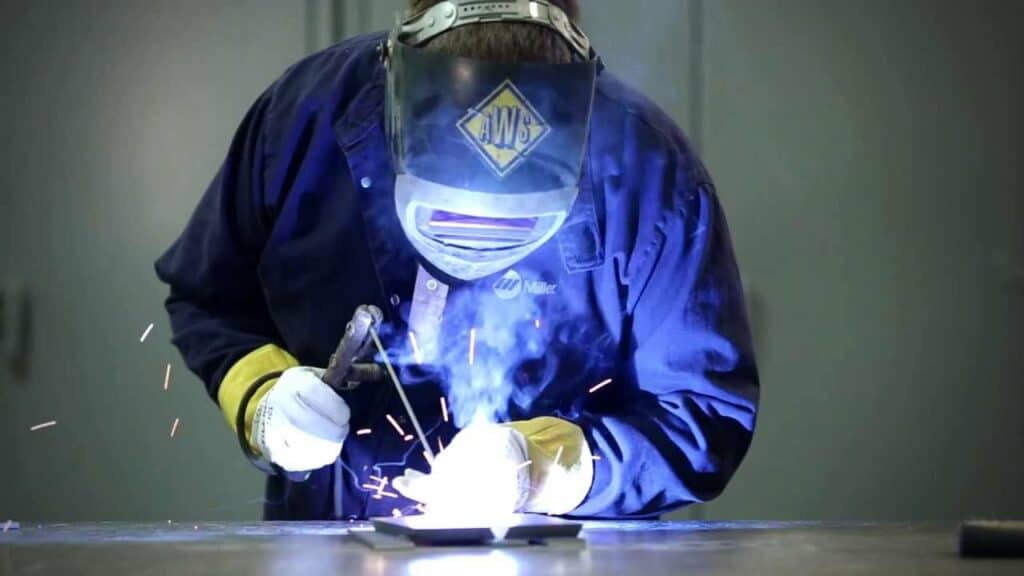Stick welding, also known as Shielded Metal Arc Welding (SMAW), or Manual Metal Arc Welding (MMA or MMAW), or Flux Shielded Arc Welding, is the most widely used welding process.
There are various advantages and limitations of stick welding, however, we cannot deny the fact that it is one of the oldest styles of welding.
And it is also extremely versatile and therefore used in areas such as heavy equipment maintenance, construction, and also pipeline welding.
Let us first understand the working of stick welding before we get into its pros and cons.
Encounter between the rod electrode and the workpiece sparks the arc in stick welding. This produces a short circuit between the two poles for a split second, allowing current to flow.
Then the arc is formed by the interaction of the workpiece and the electrode. This generates the necessary fusion heat, and the electrode also provides the protective slag and the gas shroud through the consumable core wire and the consumable coating.
Stick welding can be done with either Alternating current (AC) or Direct Current (DC) electricity.
DC, on the other hand, is the recommended polarity for stick welding because it provides various benefits such as smoother and more stable arcs, fewer outages, less weld spatter, and simpler overhead welding.
Arc welding by hand necessitates a low voltage and a high amperage. Which means the welding mechanism reduces the available mains voltage to a much lower welding voltage. Simultaneously, it supplies the needed amperage, allowing the power source to be altered and regulated.
The amperage is the most critical parameter for the quality of the connections in Manual Metal Arc Welding. As a result, even if the arc length changes, it must stay as consistent. To guarantee this, electrode welding power sources must constantly exhibit drooping characteristics.
6 Advantages of Stick welding
1.) Versatile- In stick welding, if you need to weld various materials, you may move from one kind to the other by simply changing the type of electrode you’re using, and everything else remains the same.
There are many different types of electrodes for different metals and tasks, and therefore, this way a welder can keep several rods on hand and will be prepared for a wide range of duties. This makes stick welding very versatile for multiple welding purposes.
2.) No shielding gas is required- SMAW electrodes produce their own shielding gas, mostly carbon dioxide. Therefore, you need not worry about shielding gas cylinders.
This happens because to protect the arc, the electrode flux generates its own gas. Stick welding is perfect for mobile welders since they don’t have to carry a cylinder around when performing a weld. That’s one less thing to worry about!
3.) Minimum equipment- One advantage of stick welding is that it requires less equipment to get started unlike TIG or MIG welding. The essential pieces of equipment are a machine, a ground lead, and a stinger lead. You may simply take a box of your favourite rods and get ready to weld.
4.) Outdoor usage- If you are using shielding gases, even a 3mph wind may blow away your shielding gas and cause porosity. But stick welding may be done outside in strong winds up to 35 mph.
This method is extremely resistant to the elements. Stick welders can operate in the snow, light rain, and high winds without sacrificing the quality of their welds.
5.) Low equipment cost- When compared to even the most basic MIG welders, SMAW uses extremely simple equipment that is quite affordable.
6.) Easy setup- Another advantage of stick welding is that it requires less time to set up. There’s no need to fiddle with gas flow, gas hoses, MIG wire speed, or TIG tungsten prep.
4 limitations of Stick welding
1.) Slag and debris- One difficulty in stick welding is that it generates slag, which is a byproduct of the gas produced by the electrode to protect the arc from the environment.
You must remove the hot slag from a weld once it has been completed. This is frequently accomplished using a chipping hammer, or wire brush. The slag that has fallen might potentially cause burn hazards, so therefore, it must be cleaned.
2.) Electrode Replacement- When welding on bigger materials, the welder must frequently replace the electrodes. So if you’re using a 14″ long electrode , it can only go so far before needing to be replaced frequently.
3.) Moisture- Most cellulose rods, such as 6010, are highly resistant to moisture, however, low hydrogen rods, such as 7018, can be damaged if they become damp.
Therefore, it is advisable that these rods remain in a regulated rod oven until they are used.
3.) Messier- Stick welding is a dirtier process than TIG or MIG welding, and the arc of a stick weld generates a lot of sparks. This might cause some serious injuries.
4.) Difficult to weld thinner metals- Stick welding can also be difficult on thinner metals, such as sheet metal. The electrode is prone to readily burning through these thin metals.
Smaller diameter stick electrodes can be effective on thin steel, but these rods are more difficult to operate, especially for novice welders.
Conclusion
Stick welding is one of the first and most widely used welding methods. It is the most favoured welding technology in many sectors due to its versatility, mobility, and overall cost-effectiveness.
Despite these advantages, stick welding is more difficult to master than other welding techniques. As a result, operators must be well-trained in order to create welds that match the needed requirements.







